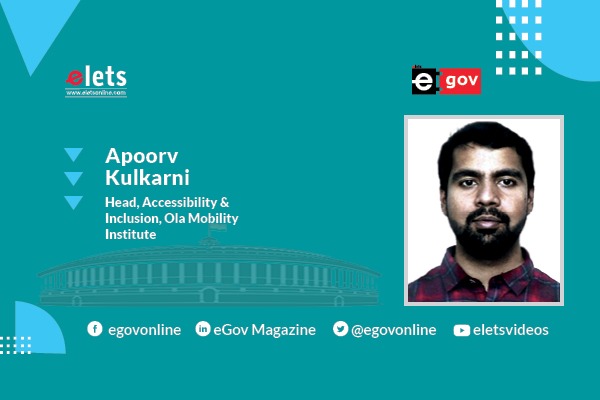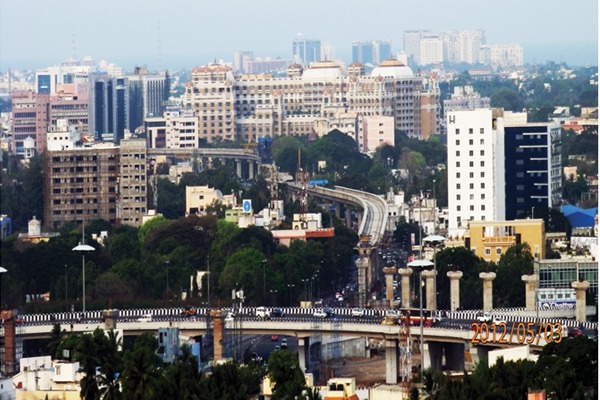
The need to shape cities as inclusive growth and innovation engines is more urgent than ever. The global aspiration to foster sustainable development under the 2030 Agenda will succeed or fail under the aegis of our urban centres. Transport systems that are safe, accessible, reliable and affordable for all, including the mobility-underprivileged communities will play a major role in making cities more inclusive. There is an opportunity to use technology-enabled mobility solutions to fast track this process, Apoorv Kulkarni, Head, Accessibility & Inclusion, Ola Mobility Institute.
Roughly 24 years ago, the urban population surpassed the non-urban population for the first time in human history. This trend is projected to continue and by 2050, nearly two- thirds of the global population will be residing in cities. In India too, the number of urban dwellers is expected to rise from 377 million in 2011 to 870 million by 2050¹ . What’s more, just by 2030, India is expected to have seven megacities with a population of 10 million each² . As our urban centres continue to proliferate, how we shape our cities in this decade will lay the foundation of the future we can expect. The Sustainable Development Goals (SDGs) recognise this opportunity. SDG 11 in particular aims to “Make cities and human settlements inclusive, safe, resilient and sustainable”. Goal 11 puts cities at the centre and includes 10 targets, with target 11.7 having a close connection with the quality of life for the citizens across the gender, age and disability (GAD) spectrum.
Target 11.7: “Provide universal access to safe, inclusive and accessible, green and public spaces, in particular for women and children, older persons and persons with disabilities” is critical to building a sustainable and inclusive city. Green spaces offer a natural environment for physical exercise, recreation and socialisation, thus promoting SDG 3, “Good Health and Wellbeing”. Similarly, they make cities more resilient to face climate risks, lower temperature, reduce energy dependency, prevent flooding and thereby contribute to SDG 7, “Affordable and Clean energy”, as well as SDG 13, “Climate action”.


A city skyline crowded by buildings
Green and public spaces, such as parks, also provide an opportunity to the poor to set up micro-businesses in the form of food stalls, children’s rides, and vending booths to earn a living. In this way, these spaces also support SDG 8, “Decent work and economic growth”.
Despite the benefits of green spaces, allocation of land, as a premium resource, is traditionally prioritised for business and commercial activities. Less affluent urbanites are often forced to take up housing in the peripheries of cities where green spaces may be plentiful but public transport systems may be underdeveloped. This, in turn, increases their reliance on personal vehicles for accessing various socioeconomic opportunities. While this results in significant economic and environmental costs, it also inhibits access to opportunities for the mobility-underprivileged groups including women and persons with disabilities. The advent of technology- powered mobility solutions has however helped in bridging this access gap.


A city skyline with ample green spaces
App-based mobility aggregators including Ola, Uber, Rappido and others use digital platforms and smartphones to match passengers with available drivers on-demand. Passengers can request and own a ride based on their requirements – from a six-seater Sports Utility Vehicle (SUV) to a humble auto-rickshaw or even a bike taxi. These modes don’t just fill the gaps left by public transport, but also strengthen the latter. They improve the first and last mile connectivity thereby increasing the reach and effectiveness of bus and train systems. These new mobility solutions contribute to Target 11.2., “provide access to safe, affordable and accessible public transport to all…” Furthermore, by facilitating maximizing asset (vehicle) utilisation and use of sustainable fuels such as Compressed Natural Gas (CNG) these solutions are aligned with SDG 7 and 13. The new-mobility solutions have also led to job creation contributing to SDG 8. The safety features available in these solutions, from driver background checks, in-app SOS functionality, the ability to share rides in real-time, and robust safety support at the backend foster gender safety and promotes SDG 5, “Gender equality”.

Women and men living with different disabilities move about in an urban environment. A man using crutches is using an app-based mobility aggregator to summon a ride.
A recent report titled, “On The Move: Urban travel experiences of persons with disabilities and a path to build more inclusive transport systems”, outlines how app-based mobility aggregators enable hailing a ride independently for a person living with a visual disability. Similarly, it illustrates how persons living with a physical disability are able to travel using these services with their assistive equipment such as a wheelchair or crutches. For the Deaf community, the in-app chat function from some providers enables communication with the driver. The hygiene and sanitisation protocols instituted by these new-mobility companies instil greater confidence among persons living with comorbidities to use shared mobility solutions during the COVID pandemic³. By providing safe, accessible, reliable and affordable mobility solutions, the app-based mobility aggregators also work towards SDG 10, “Reduced inequality.
Cities are the growth and innovation engine of the world. It will be under the aegis of urban centres that we will succeed or fail in accomplishing our goals for sustainable development along with a resilient and inclusive future. Robust transport systems which are available to all will be critical in building urban environments with access to decent work opportunities with a healthy quality of life. They will enable access to green public spaces where people can meet and bring liveliness to cities. The technology-enabled mobility solutions have a huge role in augmenting our current transport systems to meet the demands of an ever-growing urban population. If utilised well, these systems will help urban centres deliver on the promise of the big city life to their millions of current and future inhabitants.
1. Durga Shanker Mishra, O P Agarwal write: Why India needs an urbanization policy (indianexpress.com)
2. SDG 11: Sustainable Cities And Communities
Be a part of Elets Collaborative Initiatives. Join Us for Upcoming Events and explore business opportunities. Like us on Facebook , connect with us on LinkedIn and follow us on Twitter, Instagram.











